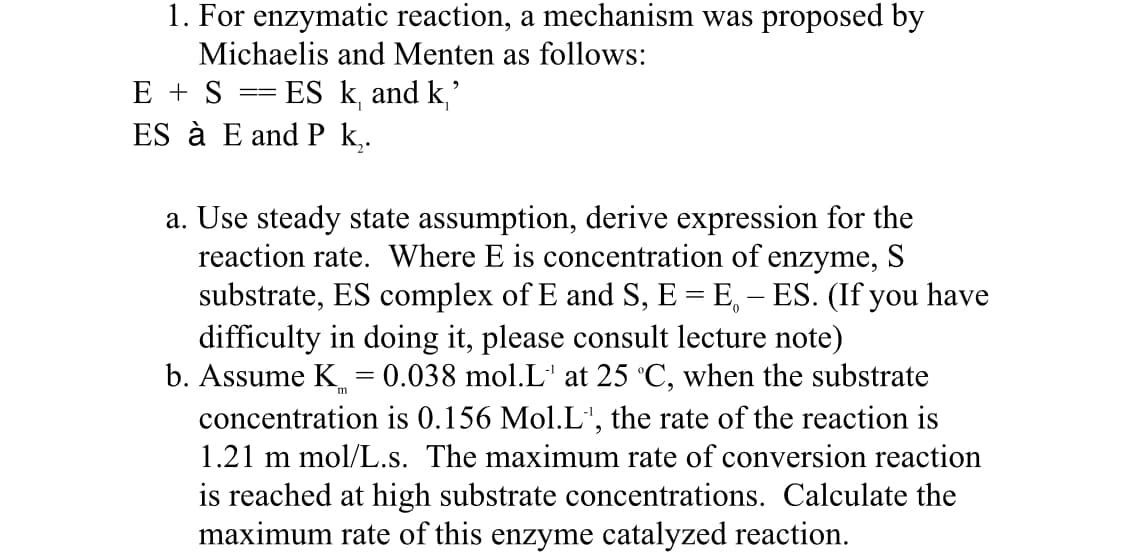1. For enzymatic reaction, a mechanism was proposed by Michaelis and Menten as follows: = ES k, and k,’ E + S ES à E and Pk,. a. Use steady state assumption, derive expression for the reaction rate. Where E is concentration of enzyme, S substrate, ES complex of E and S, E = E, – ES. (If you have difficulty in doing it, please consult lecture note) b. Assume K = 0.038 mol.L' at 25 °C, when the substrate concentration is 0.156 Mol.L', the rate of the reaction is 1.21 m mol/L.s. The maximum rate of conversion reaction is reached at high substrate concentrations. Calculate the maximum rate of this enzyme catalyzed reaction.
1. For enzymatic reaction, a mechanism was proposed by Michaelis and Menten as follows: = ES k, and k,’ E + S ES à E and Pk,. a. Use steady state assumption, derive expression for the reaction rate. Where E is concentration of enzyme, S substrate, ES complex of E and S, E = E, – ES. (If you have difficulty in doing it, please consult lecture note) b. Assume K = 0.038 mol.L' at 25 °C, when the substrate concentration is 0.156 Mol.L', the rate of the reaction is 1.21 m mol/L.s. The maximum rate of conversion reaction is reached at high substrate concentrations. Calculate the maximum rate of this enzyme catalyzed reaction.
Biology: The Dynamic Science (MindTap Course List)
4th Edition
ISBN:9781305389892
Author:Peter J. Russell, Paul E. Hertz, Beverly McMillan
Publisher:Peter J. Russell, Paul E. Hertz, Beverly McMillan
Chapter6: Energy, Enzymes, And Biological Reactions
Section: Chapter Questions
Problem 7TYK: In an enzymatic reaction: a. the enzyme leaves the reaction chemically unchanged. b. if the enzyme...
Related questions
Question

Transcribed Image Text:1. For enzymatic reaction, a mechanism was proposed by
Michaelis and Menten as follows:
ES k, and k,'
ES à E and P k,.
E + S
a. Use steady state assumption, derive expression for the
reaction rate. Where E is concentration of enzyme, S
substrate, ES complex of E and S, E = E, – ES. (If you have
difficulty in doing it, please consult lecture note)
b. Assume K = 0.038 mol.L' at 25 °C, when the substrate
concentration is 0.156 Mol.L', the rate of the reaction is
1.21 m mol/L.s. The maximum rate of conversion reaction
is reached at high substrate concentrations. Calculate the
maximum rate of this enzyme catalyzed reaction.
Expert Solution
This question has been solved!
Explore an expertly crafted, step-by-step solution for a thorough understanding of key concepts.
This is a popular solution!
Trending now
This is a popular solution!
Step by step
Solved in 3 steps with 10 images

Knowledge Booster
Learn more about
Need a deep-dive on the concept behind this application? Look no further. Learn more about this topic, biology and related others by exploring similar questions and additional content below.Recommended textbooks for you

Biology: The Dynamic Science (MindTap Course List)
Biology
ISBN:
9781305389892
Author:
Peter J. Russell, Paul E. Hertz, Beverly McMillan
Publisher:
Cengage Learning

Biochemistry
Biochemistry
ISBN:
9781305577206
Author:
Reginald H. Garrett, Charles M. Grisham
Publisher:
Cengage Learning

Biology: The Dynamic Science (MindTap Course List)
Biology
ISBN:
9781305389892
Author:
Peter J. Russell, Paul E. Hertz, Beverly McMillan
Publisher:
Cengage Learning

Biochemistry
Biochemistry
ISBN:
9781305577206
Author:
Reginald H. Garrett, Charles M. Grisham
Publisher:
Cengage Learning